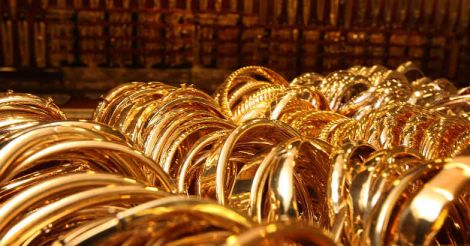New Delhi: Apparel up to Rs 1,000, biscuits and footwear will get cheaper, while gold will get slightly costlier from next month as the Center and states, excepting West Bengal, resolve to roll out GST from July 1.
The GST Council, chaired by finance minister Arun Jaitley and comprising state counterparts, on Saturday decided to tax packaged and branded food items at 5 percent, tendu leaves at 18 percent and bidi at the highest rate of 28 percent. Unlike cigarettes, there will be no cess on bidi.
While biscuits will be taxed at a flat rate of 18 percent, footwear costing up to Rs 500 will be levied a 5 percent GST and for those above this would be taxed at 18 percent.
In the textiles category, silk and jute fiber have been exempted, while cotton and natural fibre and all kinds of yarns will be levied a 5 percent GST. Man-made fiber and yarn will, however, attract a 18 percent tax rate.
All categories of fabric will attract a 5 percent rate. Man-made apparel up to Rs 1,000 will attract a 5 percent tax, lower than the existing 7 percent. Those costing above Rs 1,000, will continue to attract 12 percent.
"Both in the case of footwear and textiles, a major concession has been given," finance minister Arun Jaitley said, adding the Council will meet one more time on June 11 to review the preparedness before the July 1 rollout.
Currently, biscuits costing less than Rs 100/kg attract an average tax of 20.6 percent, while those above this price attract 23.11 percent. "Both have been fitted in the nearest tax slab of 18 percent," Jaitley said.
Footwear costing up to Rs 500 currently attracts 9.5 percent tax, and in GST it would be taxed at 5 percent. Rest are taxed between 23.1-29.58 percent, which in GST regime, would be levied 18 percent tax.
Gold will become slightly costlier as the current incidence is 2 percent and after "extensive debate" the Council proposed to tax gold and gold jewelery at 3 percent. Also, input tax credit can be claimed for gold jewelery manufacture.
Jaitley said while some states wanted a 2 percent tax rate, others were in favor of a 5 percent tax on gold and hence, the Council decided on a "vertical division".
Solar panel equipment will be taxed at 5 percent, he said, adding lottery tax is yet to be decided.
When asked about West Bengal finance minister demanding a delay in GST rollout, Jaitley said "Others did not express this view" and exuded confidence that the state too would roll out GST from July 1.
"We are quite confident of being able to stick to the target date (of July 1)," he said.
West Bengal finance minister Amit Mitra said the rollout of the Goods and Services Tax from July 1 will have "serious problems" and there is no harm in delaying its implementation by a month.
Kerala finance minister Thomas Isaac, however, said "Everybody has agreed for July 1 rollout".
The Council also agreed to set up a Committee comprising officials from Center and states to look into the complaints with regard to anti-profiteering clause that seeks to prevent companies from making undue gains post GST rollout, Jaitley said.
The final rule with regard to functioning of the Committee will be framed later.
In all, the Council at its 15th meeting decided on tax rates on 6 items including rough diamond at 0.25 percent and placed agriculture equipment at two slabs of 5 percent and 12 percent. Also, it approved two rules relating to transition and returns forms.
The GST Council also decided to amend the transition rules allowing traders and retailers to make claim of 60 percent against the CGST or SGST dues where the tax rate exceeds 18 percent. For tax rate below 18 percent, it will be retained at 40 percent.
The draft transition law provided that once GST is implemented, a company can claim credit of up to 40 percent of their Central GST dues for excise duty paid on stock held by businesses prior to the rollout.
Several dealers are choosing to wait and watch rather than buy and holding on to inventories and lobbied the government seeking an increase in the credit limit.
Revenue secretary Hasmukh Adhia said that for transition stock, the government will refund 100 percent excise duty for goods costing above Rs 25,000, bears a brand name of the manufacturer and are serially numbered like TV, fridge or car chasis.
"On all those items, even if it is coming through the dealer, the manufacturer will give the credit transfer document to the distributor and the distributor will be able to take 100 percent credit for the big ticket items," Adhia said.
With regard to CSD canteens, Jaitley said since current price levels were to be maintained, so the current position where they maintain half the taxation benefit will be maintained.
Jaitley said the GST Council will meet again on June 11 and review the rates based on industry representations in case the fitment committee finds that there is a substantial increase from the present burden. It will also take up the rules for e-way bill and accounts and records.
Also, the company developing the technology backbone for GST -- GST Network-- made a detailed presentation on the amount of work done and IT preparedness.
The GST Council in its previous meeting last month had fixed over 1,200 goods and 500 services in the tax bracket of 5, 12, 18 and 28 percent.
Prices of foodgrains, especially wheat and rice, has been exempt from GST. Currently, some states levy Value Added Tax (VAT) on them. While common-use products like hair oil, soaps and toothpaste as also electricity will cost less from July 1.
GST will subsume all major levies including excise, service tax and VAT, unifying 16 different taxes, and make India a single market.

























